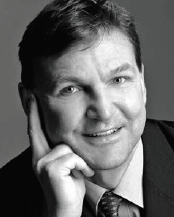Who Rules Iran? The Structure of Power in the Islamic Republic.
Washington Institute for Near East Policy and Konrad-Adenauer-Foundation
Washington D.C.,USA 2000
239 pages, 1 map, 19 diagrams
ISBN 0-944029-39-6
$ 29.95
Can be ordered on Amazon
Iran's hybrid regime is still a mystery today. Who rules the Islamic Republic of Iran? Is it a republic governed by a president who has been elected by the people? Or is it a Shiite theocracy, governed by a Supreme Leader who is legitimized by theological concepts and revolutionary dogmas? Who is a reformer? Who is a conservative hardliner? And what do these terms actually mean? How relevant are such concepts in a political system with numerous, often overlapping and always competing power centers? And which centers of power are more powerful than others? Those who promote Iran's national interest as a state or those who only serve the revolution? If you are looking for clear and understandable answers to these and many other questions, you should read this book by Wilfried Buchta, an internationally recognized expert on Iran.
Foreign Affairs
CAPSULE REVIEW
Who Rules Iran? The Structure of Power in the Islamic Republic
By Wilfried Buchta
Reviewed By L. Carl Brown, Princeton University
November / December 2000
"An invaluable book for anyone who wants to know who's who in Islamic Iran, sort out the various governing institutions, look up Iranian election results, learn about the various opposition groups inside Iran and beyond, and more. At the same time, the book is more than just a handy reference tool. It is also a very readable study of modern Iran that assesses "Iran's maze of power centers," the Iranian opposition, and finally the ongoing power struggle from 1997 to 2000 between moderates and fundamentalists. Buchta is especially good when presenting the many vested interests intent on stifling liberalization efforts. These include the paramilitary Basij, the Revolutionary Guard, and the many foundations (bonyads) that operate as autonomous sources of patronage by dispensing economic fiefdoms that lie beyond governmental control. The author's sobering analysis suggests that President Mohammad Khatami and a majority in the Majlis (parliament) may not prevail. Referring to Islamic Iran's first president-who was ousted and forced to flee the country in 1981 -- the conclusion asks, "Is Bani-Sadr's past Khatami's future?"
Who Rules Iran? The Structure of Power in the Islamic Republic
By Wilfried Buchta
"Perhaps the only book that effectively explains how Iran’s political system works. While it needs an update, it’s an essential guidebook for those interested in how power is brokered in the Islamic Republic."
Thomas Erdbrink, Tehran bureau chief for The New York Times, in:
Atlantic Council, 21. 09. 2018
https://www.atlanticcouncil.org/blogs/iransource/the-books-the-trump-administration-should-read-to-understand-iran/



